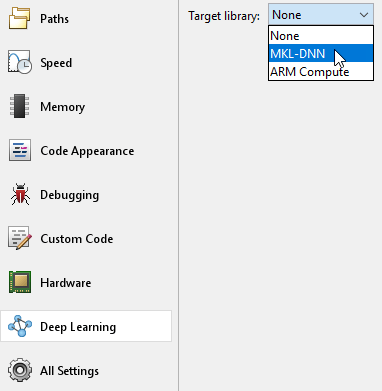Code Generation for Deep Learning Networks with MKL-DNN
With MATLAB®
Coder™, you can generate code for prediction from an already trained convolutional
neural network (CNN), targeting an embedded platform that uses an Intel® processor. The code generator takes advantage of the Intel Math Kernel Library for Deep Neural Networks (MKL-DNN). The generated code
implements a CNN with the architecture, layers, and parameters specified in the input SeriesNetwork (Deep Learning Toolbox) or
DAGNetwork (Deep Learning Toolbox) network
object.
Generate code by using one of these methods:
The standard
codegencommand for C/C++ code generation from MATLAB code.The MATLAB Coder app.
Requirements
On Windows®, code generation for deep learning networks with the
codegenfunction requires Microsoft® Visual Studio® 2015 or later.MATLAB Coder Interface for Deep Learning. To install this support package, select it from the MATLAB Add-Ons menu.
Intel Math Kernel Library for Deep Neural Networks (MKL-DNN)
Deep Learning Toolbox™.
Environment variables for the compilers and libraries. For more information, see Prerequisites for Deep Learning with MATLAB Coder.
Code Generation by Using codegen
Write an entry-point function in MATLAB that:
Uses the
coder.loadDeepLearningNetworkfunction to construct and set up a CNN network object. For more information, see Load Pretrained Networks for Code Generation.Calls the
predict(Deep Learning Toolbox) method of the network on the entry-point function input.Specifies a
MiniBatchSizein thepredictmethod to manage memory usage for prediction on multiple input images or observations.
For example:
function out = googlenet_predict(in) %#codegen % A persistent object mynet is used to load the series network object. % At the first call to this function, the persistent object is constructed and % setup. When the function is called subsequent times, the same object is reused % to call predict on inputs, thus avoiding reconstructing and reloading the % network object. persistent mynet; if isempty(mynet) mynet = coder.loadDeepLearningNetwork('googlenet'); end % pass in input out = predict(mynet,in,'MiniBatchSize',2);
Create a code generation configuration object for MEX or for a static or dynamically linked library. To specify code generation parameters for MKL-DNN, set the
DeepLearningConfigproperty to acoder.MklDNNConfigobject that you create withcoder.DeepLearningConfig.cfg = coder.config('lib'); cfg.TargetLang = 'C++'; cfg.DeepLearningConfig = coder.DeepLearningConfig('mkldnn');
Run the
codegencommand. Use the-configoption to specify the configuration object. Use the-argsoption to specify the input type. The input size corresponds to the input layer size of the GoogLeNet network with16different images or observations.codegen -config cfg googlenet_predict -args {ones(224,224,3,16)} -report
Note
You can specify half-precision inputs for code generation. However, the code generator type casts the inputs to single-precision. The Deep Learning Toolbox uses single-precision, floating-point arithmetic for all computations in MATLAB.
Generated Code
The network is generated as a C++ class containing an array of layer classes. The
setup() method of the class sets up handles and allocates memory for
each layer of the network object. The predict() method invokes
prediction for each of the layers in the network. The code generator produces the function
googlenet_predict() in googlenet_predict.cpp that
corresponds to the MATLAB entry-point function. This function constructs the static object for the
network and invokes the setup and predict methods.
Binary files are exported for layers with parameters such as fully connected and
convolution layers in the network. For example, files
cnn_googlenet_conv*_w and cnn_googlenet_conv*_b
correspond to weights and bias parameters for the convolution layers in the
network.
By default, the generated application looks for the weight files in the
codegen folder. If you are relocating the generated application and
weight files to a different location such as an embedded board, create an environment
variable called CODER_DATA_PATH, whose value is the location of the
relocated weight files. The generated application will then look for the weight files in
this location.
Code Generation by Using the MATLAB Coder App
Follow the usual steps for specifying the entry-point function and specifying input types. See Generate C Code by Using the MATLAB Coder App.
In the Generate Code step:
Set Language to C++.
Click More Settings. In the Deep Learning pane, set Target library to
MKL-DNN.
Generate code.
See Also
codegen | coder.DeepLearningConfig | coder.MklDNNConfig | coder.loadDeepLearningNetwork
Topics
- Generate Code for a Deep Learning Network for x86-64 Platforms Using Advanced Vector Instructions
- Workflow for Deep Learning Code Generation with MATLAB Coder
- Code Generation for Deep Learning Networks with ARM Compute Library
- Code Generation for Deep Learning Networks by Using cuDNN (GPU Coder)
- Code Generation for Deep Learning Networks by Using TensorRT (GPU Coder)
- Generate C Code by Using the MATLAB Coder App